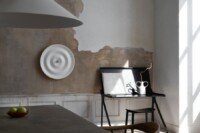by Design Concepts Global
Share

Creating an inviting and visually appealing space requires a keen understanding of how to blend different elements harmoniously. In modern interiors, the art of mixing textures and materials has become a key trend, offering depth, contrast, and a touch of sophistication. As an architecture and interior design company in Dubai & Saudi Arabia, understanding the role of materials for interior design and their finishes is crucial to achieving stunning results.
The Importance of Texture in Interior Design
Texture in interior design refers to the surface quality of a material. It can be rough or smooth, soft or hard, glossy or matte. Incorporating a variety of textures adds a tactile dimension to a space, making it feel more dynamic and engaging. Textures can evoke emotional responses and set the tone for a room plush fabrics add warmth and comfort, while sleek metals bring a sense of modernity.
Choosing the Best Materials for Interior Design
Selecting the best materials for interior design involves balancing aesthetics with functionality. Different materials used in interior design include natural stone, wood, metal, glass, and textiles. Each material has its unique properties and visual appeal
- Wood: Offers warmth and a natural feel. It pairs well with almost any material, making it a versatile choice.
- Metal: Brings a modern, industrial edge to interiors. It’s durable and can be used in various finishes such as brushed, polished, or matte.
- Glass: Adds transparency and lightness. It’s perfect for creating a sense of openness and can be used in partitions or as decorative elements.
- Stone: Exudes luxury and strength. Marble and granite are popular choices for countertops, floors, and accent walls.
- Textiles: Softens a space and adds comfort. From velvet to linen, the choice of fabric can significantly influence the room’s ambiance.
Combining Materials and Finishes for Interior Design
When mixing materials and finishes for interior design, consider the following tips
- Contrast and Balance: Use contrasting textures to create visual interest. Pair smooth surfaces like glass or polished metal with rougher materials like wood or stone.
- Color Harmony: Ensure the colors of different materials complement each other. A cohesive color palette helps unify the diverse textures and materials.
- Proportion and Scale: Be mindful of the scale of the materials. Large patterns or textures can overwhelm a small space, while subtle textures might get lost in a larger room.
- Layering: Layering different materials adds depth. Start with a base material and build upon it with complementary textures and finishes.
Luxury Interior Materials
Luxury interior materials elevate a space’s aesthetic and often include high-quality, unique finishes. Materials such as exotic woods, Italian marble, and hand-crafted metals are synonymous with luxury. Incorporating these materials requires careful planning to ensure they complement the overall design without overpowering it.
Final Thoughts
Mixing textures and materials in modern interiors is a delicate balance of creativity and technical knowledge. As an architecture and interior design company in Dubai, staying updated with the latest trends in materials and finishes for interior design is essential. By thoughtfully combining different materials, textures, and finishes, you can create spaces that are not only visually stunning but also functional and inviting. Embrace the diversity of materials available, and let your interiors tell a story of luxury and innovation.





